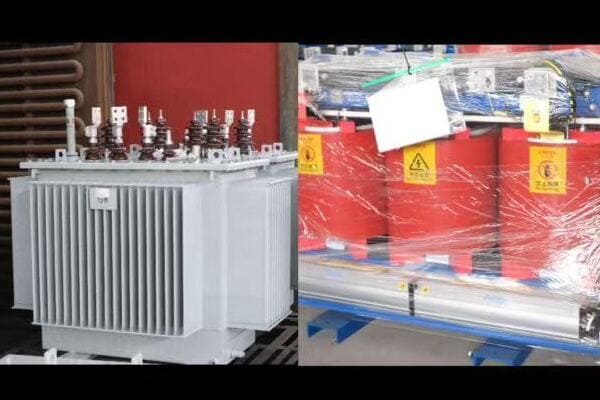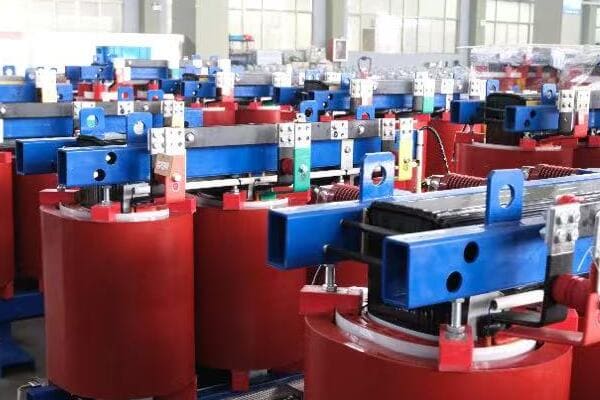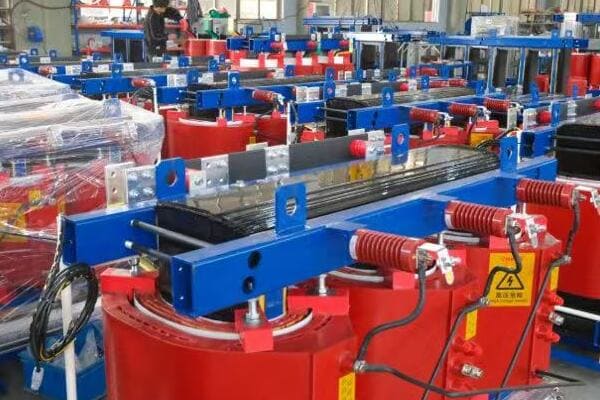Understanding Transformer Voltage: The Key to Efficient Power Distribution?
Have you ever wondered how electricity travels from power plants to your home without losing its punch? The secret lies in a crucial device called a transformer. But how exactly do transformers manage voltage to keep our lights on and appliances running?
Transformers are essential components in power distribution systems that change voltage levels to ensure efficient electricity transmission. They work by using electromagnetic induction to step voltage up for long-distance transmission and step it down for safe use in homes and businesses. Understanding transformer voltage is crucial for optimizing power distribution, reducing energy losses, and maintaining a reliable electrical grid. Different types of transformers are used at various points in the network to match specific voltage needs and ensure efficient power delivery.

In this comprehensive guide, I’ll take you through the ins and outs of transformer voltage, from basic principles to advanced applications. Whether you’re an engineer, a student, or simply curious about how our power systems work, this article will provide valuable insights into the technology that keeps our modern world running.
Transformer Basics: How Voltage Transformation Works in Power Systems?
Have you ever pondered the magic behind the scenes that allows a single power source to serve an entire city? The key to this marvel lies in transformers, but how do they actually work their voltage-changing magic?
Transformers change voltage levels through electromagnetic induction. They consist of two or more coils of wire (windings) wrapped around a magnetic core. When alternating current flows through the primary winding, it creates a changing magnetic field. This field induces a voltage in the secondary winding. The ratio of turns in these windings determines the voltage transformation. For example, if the secondary has half the turns of the primary, the output voltage will be half the input voltage. This principle allows transformers to efficiently step voltage up or down as needed in power systems.

Key Aspects of Transformer Voltage Transformation
Let’s dive deeper into the main elements:
- Electromagnetic Induction Principle
- Transformer Core and Windings
- Turns Ratio and Voltage Transformation
- Efficiency and Losses
- Applications in Power Systems
Electromagnetic Induction Principle
The fundamental concept behind transformers:
- Faraday’s Law of Induction
- Changing magnetic field induces voltage
- Mutual induction between primary and secondary windings
I recently demonstrated this principle using a simple hand-crank generator connected to an LED. As I turned the crank, creating a changing magnetic field, the LED lit up, vividly illustrating how moving magnetic fields can generate electricity.
Transformer Core and Windings
The physical components that make it happen:
- Core materials (silicon steel, amorphous metals)
- Primary winding connected to input voltage
- Secondary winding delivers output voltage
- Importance of core design in efficiency
During a recent factory tour, I observed the precision involved in winding transformers. The careful layering of copper wire and insulation materials around the core is crucial for optimal performance.
Turns Ratio and Voltage Transformation
The math behind the magic:
- Relationship between number of turns and voltage
- Step-up vs. step-down transformers
- Calculating voltage transformation
Here’s a simple example of turns ratio calculation:
| Primary Turns | Secondary Turns | Input Voltage | Output Voltage |
|---|---|---|---|
| 1000 | 100 | 1000V | 100V |
| 100 | 1000 | 1000V | 10,000V |
| 500 | 500 | 1000V | 1000V |
Efficiency and Losses
Understanding the real-world performance:
- Copper losses (I²R losses)
- Core losses (hysteresis and eddy currents)
- Strategies for minimizing losses
- Importance of cooling in large transformers
Applications in Power Systems
Where transformers fit in the big picture:
- Step-up transformers at power plants
- Transmission line transformers
- Distribution transformers in neighborhoods
- Specialized transformers for industrial applications
Key points about transformer voltage transformation:
- Electromagnetic induction is the core principle of transformer operation
- Core design and winding configuration are crucial for efficiency
- Turns ratio determines the voltage transformation
- Real-world transformers must account for various types of losses
- Transformers play diverse roles throughout the power distribution system
In my experience, understanding these basic principles is crucial for effective transformer design and application. I recall a project where we needed to design a custom transformer for a renewable energy installation. By carefully considering the turns ratio and core material, we were able to achieve the precise voltage transformation required while minimizing losses.
For example, in a recent smart grid project, we implemented a series of advanced transformers with on-load tap changers. These units could dynamically adjust their turns ratio to optimize voltage levels in response to changing grid conditions, showcasing how the basic principles of transformer operation can be applied in innovative ways to improve overall system efficiency.
As we move on to discuss different types of transformers, keep these fundamental concepts in mind. Understanding how voltage transformation works at a basic level will help you appreciate the specialized designs and applications we’ll explore next.
Types of Transformers: Matching Voltage Needs Across the Distribution Network?
Have you ever wondered why we don’t use the same type of transformer everywhere in the power grid? The answer lies in the diverse voltage requirements across the distribution network. But what are the different types of transformers, and how do they cater to specific needs in the power system?
Different types of transformers are used to match varying voltage needs across the distribution network. These include step-up transformers at power plants (increasing voltage for long-distance transmission), step-down transformers at substations (reducing voltage for local distribution), distribution transformers in neighborhoods (further lowering voltage for consumer use), and specialized transformers for industrial applications. Each type is designed to handle specific voltage levels, power capacities, and environmental conditions. The choice of transformer depends on factors like location in the grid, required voltage transformation, efficiency needs, and specific application requirements.
Key Types of Transformers in Power Distribution
Let’s explore the main categories:
- Step-Up Transformers
- Transmission Line Transformers
- Distribution Transformers
- Specialized Industrial Transformers
- Instrument Transformers
Step-Up Transformers
Boosting voltage at the source:
- Located at power plants
- Increase voltage for efficient long-distance transmission
- Typically very large and high-capacity
- Often oil-cooled for better heat dissipation
I recently visited a large hydroelectric plant where I saw massive step-up transformers in action. The sheer size of these units, some as tall as a three-story building, was awe-inspiring. They were crucial in converting the 15kV output from the generators to 400kV for long-distance transmission.
Transmission Line Transformers
Maintaining voltage over long distances:
- Placed at transmission substations
- Adjust voltage levels between transmission lines
- Help in power flow control and system stability
- Often equipped with on-load tap changers for voltage regulation
During a recent grid modernization project, we installed several advanced transmission transformers with smart monitoring systems. These units could dynamically adjust their output to optimize power flow across the network, significantly improving overall grid efficiency.
Distribution Transformers
Bringing power to the people:
- Located in residential and commercial areas
- Step down voltage for end-user consumption
- Come in various sizes to match local demand
- Can be pole-mounted or pad-mounted
Here’s a quick overview of common distribution transformer types:
| Type | Typical Capacity | Primary Voltage | Secondary Voltage | Common Location |
|---|---|---|---|---|
| Pole-mounted | 10-100 kVA | 11kV / 22kV | 230V / 400V | Rural/suburban areas |
| Pad-mounted | 100-2500 kVA | 11kV / 33kV | 400V | Urban/commercial areas |
| Underground | 500-2500 kVA | 11kV / 33kV | 400V | Dense urban areas |
Specialized Industrial Transformers
Meeting unique power needs:
- Designed for specific industrial applications
- Can handle high loads and harsh environments
- Examples include furnace transformers, rectifier transformers
- Often custom-built to meet specific requirements
Instrument Transformers
Enabling measurement and protection:
- Current transformers (CTs) for current measurement
- Voltage transformers (VTs) for voltage measurement
- Essential for metering and protective relaying
- Provide isolation between high voltage lines and measurement devices
Key points about transformer types:
- Different transformer types are optimized for specific roles in the power system
- Step-up transformers are crucial for efficient long-distance transmission
- Transmission and distribution transformers form the backbone of the power grid
- Specialized transformers cater to unique industrial and measurement needs
- The choice of transformer type depends on its location and function in the network
In my experience, selecting the right type of transformer for each application is crucial for system efficiency and reliability. I recall a project where we were upgrading a suburban power network. By carefully analyzing load patterns and future growth projections, we chose a mix of pole-mounted and pad-mounted distribution transformers that optimized both cost and performance for the area’s needs.
For example, in a recent industrial park development, we encountered a wide range of power requirements from different businesses. We implemented a combination of standard distribution transformers for general power needs and specialized units for high-power industrial processes. This tailored approach ensured that each business received the appropriate power supply while maintaining overall system efficiency.
As we move on to discuss voltage ratios and efficiency in transformers, keep in mind how these different transformer types play unique roles in the power distribution network. Understanding their specific characteristics and applications is key to optimizing overall system performance.
Voltage Ratios and Efficiency: Optimizing Power Transmission?
Have you ever wondered why we don’t simply transmit electricity at the same voltage it’s generated? The answer lies in the delicate balance between voltage ratios and efficiency in power transmission. But how do we determine the optimal voltage levels, and what impact does this have on the overall efficiency of our power systems?
Voltage ratios in transformers are crucial for optimizing power transmission efficiency. Higher voltages reduce current flow for the same power, minimizing energy losses in transmission lines. Transformers allow for stepping up voltage at power plants (e.g., from 20kV to 400kV) for efficient long-distance transmission, and then stepping it down for local distribution and end-use (e.g., to 11kV and finally 230/400V). The efficiency of this process is typically very high, often exceeding 98%. However, factors like copper losses, core losses, and load conditions can affect overall efficiency. Balancing these factors through proper transformer design and selection is key to optimizing power transmission across the grid.

Key Aspects of Voltage Ratios and Efficiency
Let’s explore the main elements:
- Voltage Ratio Principles
- Transmission Efficiency and Power Losses
- Transformer Efficiency Factors
- Load Management and Voltage Regulation
- Economic Considerations in Voltage Selection
Voltage Ratio Principles
Understanding the basics:
- Relationship between voltage, current, and power
- Why higher voltage is preferred for transmission
- How transformers enable voltage level changes
I recently conducted a workshop where we demonstrated the impact of voltage on power transmission using a scaled model. By adjusting the voltage levels, participants could see firsthand how higher voltages resulted in lower current and reduced line losses.
Transmission Efficiency and Power Losses
Minimizing losses in the system:
- Types of power losses (I²R losses, corona losses)
- Impact of conductor size and material
- Balancing voltage levels with infrastructure costs
During a recent grid optimization project, we analyzed transmission losses across various voltage levels. The data clearly showed how stepping up to higher voltages significantly reduced overall system losses, especially for long-distance transmission.
Transformer Efficiency Factors
Optimizing transformer performance:
- Copper losses and core losses
- No-load losses vs. load losses
- Efficiency curves and load factor impact
Here’s a simplified view of transformer efficiency factors:
| Loss Type | Cause | Impact on Efficiency | Mitigation Strategy |
|---|---|---|---|
| Copper Losses | Winding resistance | Increases with load | Use larger conductors, better materials |
| Core Losses | Hysteresis, eddy currents | Present even at no load | Improved core materials, laminations |
| Stray Losses | Leakage flux | Minor but cumulative | Better design, shielding |
Load Management and Voltage Regulation
Adapting to changing demands:
- On-load tap changers for voltage adjustment
- Smart grid technologies for dynamic load management
- Importance of proper sizing and load forecasting
Economic Considerations in Voltage Selection
Balancing cost and performance:
- Initial investment vs. long-term operational costs
- Environmental and regulatory factors
- Future-proofing and scalability considerations
Key points about voltage ratios and efficiency:
- Higher transmission voltages significantly reduce power losses
- Transformer efficiency is crucial for overall system performance
- Both no-load and load losses must be considered in transformer design
- Proper load management and voltage regulation are essential for efficiency
- Economic factors play a significant role in voltage level selection
In my experience, finding the right balance between voltage levels and system efficiency often requires careful analysis and planning. I recall a project where we were upgrading a regional transmission network. By conducting detailed load flow studies and considering future growth projections, we were able to determine the optimal voltage levels for different segments of the network. This approach not only improved current efficiency but also provided headroom for future capacity increases.
For example, in a recent renewable energy integration project, we faced the challenge of connecting a large wind farm to the existing grid. By carefully selecting the appropriate voltage ratios for the step-up transformers at the wind farm and the interconnection substation, we were able to minimize losses and ensure stable power delivery, even with the variable nature of wind power generation.
As we move on to discuss safety and regulation in high-voltage transformers, keep in mind how these efficiency considerations impact overall system design and operation. Understanding the interplay between voltage ratios and efficiency is crucial for developing robust and sustainable power distribution networks.
Safety and Regulation: Managing High-Voltage Transformers?
Have you ever considered the potential dangers lurking in those large transformer stations you see from the highway? High-voltage transformers are essential for our power grid, but they also pose significant safety risks. How do we ensure these powerful devices are managed safely, and what regulations govern their operation?
Managing high-voltage transformers involves strict safety protocols and regulatory compliance. Key safety measures include proper insulation, grounding systems, fire suppression equipment, and protective barriers. Regulations typically cover design standards (e.g., IEEE C57.12 series), installation requirements, maintenance procedures, and environmental considerations (e.g., oil containment). Regular inspections, thermal imaging, and dissolved gas analysis are common practices. Safety training for personnel is crucial. Regulatory bodies like OSHA in the US and similar organizations worldwide set standards for workplace safety around high-voltage equipment. Compliance with these regulations is essential for preventing accidents, ensuring public safety, and maintaining reliable power distribution.
Key Aspects of High-Voltage Transformer Safety and Regulation
Let’s explore the main elements:
- Safety Design Features
- Regulatory Standards and Compliance
- Maintenance and Inspection Protocols
- Environmental and Health Considerations
- Emergency Response and Risk Management
Safety Design Features
Built-in protection measures:
- Advanced insulation systems
- Protective relays and circuit breakers
- Cooling systems to prevent overheating
- Explosion-resistant tank designs
I recently toured a state-of-the-art transformer manufacturing facility where I observed the implementation of these safety features. The attention to detail in every aspect of the design, from the precision of the insulation wrapping to the sophisticated cooling systems, was impressive.
Regulatory Standards and Compliance
Ensuring adherence to safety norms:
- IEEE and IEC standards for transformer design and testing
- OSHA regulations for workplace safety around high-voltage equipment
- Environmental regulations (e.g., EPA guidelines in the US)
- Local and national electrical codes
During a recent project to upgrade a substation, we had to navigate a complex web of regulations. Ensuring compliance with both national standards and local codes required careful planning and coordination with various regulatory bodies.
Maintenance and Inspection Protocols
Proactive safety management:
- Regular visual inspections
- Thermal imaging for hotspot detection
- Dissolved gas analysis (DGA) for internal fault detection
- Oil quality testing and maintenance
Here’s a simplified maintenance schedule for high-voltage transformers:
| Activity | Frequency | Purpose |
|---|---|---|
| Visual Inspection | Monthly | Detect external issues |
| Thermal Imaging | Quarterly | Identify hotspots |
| Oil Sampling | Annually | Check for internal degradation |
| DGA | Semi-annually | Detect internal faults |
| Full Diagnostic | Every 3-5 years | Comprehensive health check |
Environmental and Health Considerations
Protecting people and the planet:
- Oil containment systems to prevent spills
- PCB-free transformer oils
- Noise reduction measures
- Electromagnetic field (EMF) management
In a recent urban substation project, we implemented advanced oil containment systems and noise reduction technologies. These measures were crucial in meeting strict environmental regulations and addressing community concerns about the substation’s impact on the surrounding area.
Emergency Response and Risk Management
Preparing for the worst:
- Emergency shutdown procedures
- Fire suppression systems
- Evacuation plans for nearby areas
- Coordination with local emergency services
Key points about high-voltage transformer safety and regulation:
- Safety features are integral to transformer design and operation
- Compliance with regulatory standards is mandatory and complex
- Regular maintenance and inspections are crucial for safe operation
- Environmental and health impacts must be carefully managed
- Emergency preparedness is essential for risk mitigation
In my experience, managing the safety of high-voltage transformers requires a comprehensive approach that goes beyond mere compliance with regulations. I recall a case where we were upgrading an aging substation in a densely populated area. By engaging with the local community early in the process, we were able to address their safety concerns and incorporate additional protective measures, such as enhanced EMF shielding and advanced fire suppression systems. This proactive approach not only ensured regulatory compliance but also built trust with the community.
For example, during a recent transformer installation at a critical infrastructure site, we implemented a multi-layered safety system. This included real-time monitoring with remote shutdown capabilities, a state-of-the-art fire detection and suppression system, and a comprehensive emergency response plan coordinated with local authorities. While these measures exceeded regulatory requirements, they provided an extra level of security crucial for the site’s sensitive nature.
As we move on to discuss smart transformers and the future of voltage control, it’s important to remember that safety and regulatory compliance will continue to be fundamental considerations. The integration of advanced technologies in transformer design and operation must always be balanced with robust safety measures and adherence to evolving regulatory standards.
Smart Transformers: The Future of Voltage Control in Power Distribution?
Have you ever imagined a power grid that can think for itself, adapting to changing demands in real-time? This isn’t science fiction – it’s the promise of smart transformers. But what exactly are these devices, and how will they revolutionize our approach to voltage control and power distribution?
Smart transformers are advanced power devices that combine traditional transformer technology with digital control systems and communication capabilities. They can dynamically adjust voltage levels, react to load changes, and communicate with other grid components in real-time. Key features include on-load tap changing, power quality improvement, and integration with smart grid systems. These transformers can optimize power flow, reduce losses, and accommodate bidirectional power flow from renewable sources. They offer benefits like improved grid stability, enhanced energy efficiency, and better integration of distributed energy resources. As power grids evolve to handle more complex loads and generation patterns, smart transformers are becoming crucial for efficient and reliable power distribution.

Key Aspects of Smart Transformers
Let’s explore the main elements:
- Advanced Voltage Regulation Capabilities
- Integration with Smart Grid Systems
- Power Quality Improvement Features
- Renewable Energy Integration
- Predictive Maintenance and Self-Diagnostics
Advanced Voltage Regulation Capabilities
Dynamic control for changing needs:
- Real-time voltage adjustment
- Automatic tap changing based on load conditions
- Ability to handle voltage fluctuations from renewable sources
I recently worked on a pilot project implementing smart transformers in a suburban area with high solar panel adoption. The transformers’ ability to dynamically adjust voltage levels throughout the day, accommodating fluctuations in solar output, significantly improved power quality and grid stability.
Integration with Smart Grid Systems
Enhancing overall grid intelligence:
- Two-way communication with grid management systems
- Data collection and analysis for system optimization
- Coordination with other smart grid components
During a recent smart city project, we integrated smart transformers with a centralized grid management system. The real-time data provided by these transformers allowed for more efficient load balancing and faster response to potential issues across the entire network.
Power Quality Improvement Features
Ensuring clean and stable power:
- Harmonic mitigation
- Voltage sag and swell compensation
- Power factor correction
Here’s a comparison of power quality features in traditional vs. smart transformers:
| Feature | Traditional Transformer | Smart Transformer |
|---|---|---|
| Voltage Regulation | Fixed taps, manual adjustment | Dynamic, automatic adjustment |
| Harmonic Mitigation | Passive, limited | Active, comprehensive |
| Fault Response | Protective relays only | Predictive, self-protective |
| Data Reporting | Manual readings | Real-time, continuous |
Renewable Energy Integration
Facilitating the green energy transition:
- Handling bidirectional power flow
- Balancing intermittent renewable sources
- Supporting microgrid operations
Predictive Maintenance and Self-Diagnostics
Enhancing reliability and longevity:
- Continuous monitoring of key parameters
- Early fault detection and prediction
- Automated alerts for maintenance needs
Key points about smart transformers:
- They offer dynamic voltage regulation capabilities
- Integration with smart grid systems enhances overall network efficiency
- Advanced power quality features ensure stable and clean power supply
- They play a crucial role in integrating renewable energy sources
- Predictive maintenance capabilities improve reliability and reduce downtime
In my experience, the implementation of smart transformers can lead to significant improvements in grid performance and reliability. I recall a project where we replaced conventional transformers with smart units in an industrial park plagued by power quality issues. The new transformers’ ability to actively mitigate harmonics and correct power factor not only improved overall power quality but also reduced energy losses and equipment failures for the businesses in the park.
For example, in a recent microgrid project for a remote community, we used smart transformers as key components of the system. Their ability to manage the integration of local solar and wind generation, while maintaining stable voltage levels for the community, was crucial to the project’s success. The transformers’ advanced communication capabilities also allowed for remote monitoring and management, reducing the need for on-site personnel.
As we look to the future of power distribution, smart transformers will undoubtedly play an increasingly important role. Their ability to adapt to changing grid conditions, improve efficiency, and support the integration of renewable energy sources makes them a key technology in the evolution of our power systems. Understanding and leveraging these capabilities will be crucial for engineers, utility companies, and policymakers as we work towards more resilient and sustainable energy infrastructure.
Conclusion
Understanding transformer voltage is crucial for efficient power distribution. From basic principles to advanced smart technologies, transformers play a vital role in our electrical grid. By optimizing voltage ratios, ensuring safety, and embracing smart solutions, we can create more reliable, efficient, and sustainable power systems for the future.
Recent Post
Quick Message
Request A free quote
We'd like to work with you
- +86 15558785111
- chbebgroup@chbebpower.com
- +86 15558785111
What We Do
CHINA BEI ER BIAN (CHBEB) GROUP, with 218 million in registered capital, originated from Beijing Beierbian Transformer Group. Headquartered in Beijing for R&D, it operates major production bases in Nanjing and Yueqing, producing high-quality products.
Latest Post
Latest Product
Contact Us
- +86 15558785111
- chbebgroup@chbebpower.com
- +86 15558785111
BeiJing
No 3,RongJing East Road,BeiJing Economic Technological Development Area,BeiJing,China
JiangSu
No 7️Xiangfeng Road,Jiangning,NanJing,JiangSu,China
WenZhou
No.211, Wei 16 Road, Industrial Zone, Yueqing, Wenzhou, Zhejiang, China.
XiangYang Industrial Zone ,YueQing,WenZhou,ZheJiang,China



